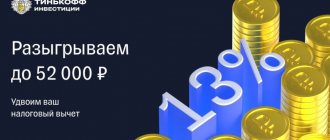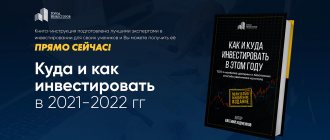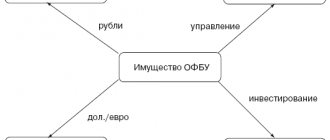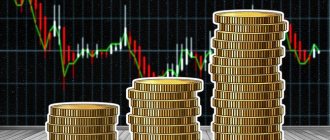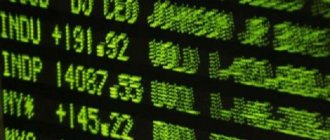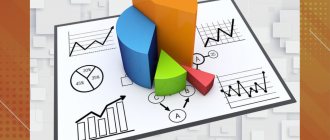Mutual Funds are funds financed by small and medium-sized investors and managed by an independent company. Essentially, this is a type of investment portfolio consisting of different assets (stocks, bonds, futures, precious metals, etc.), the diversification of which is carried out by qualified specialists.
The capital of such a fund is expressed in shares, their value is determined based on the results of the trading day. How the calculation occurs, how mutual funds (MFs) work and how they differ from mutual funds and ETFs - we will understand in today’s material.
What is a mutual fund
So, a mutual fund is the funds of investors invested in various types of instruments. The main advantage of such investments is diversification. The funds work with a wide range of assets. Investors' money is invested in stocks, bonds, derivatives, real estate, businesses, precious metals, etc.
An investor with a small capital needs to solve only one task on his own - to choose a investment fund that is suitable in terms of profitability, commissions and a set of financial instruments.
The value of the fund's securities is determined by the market value of the investment portfolio and is recalculated daily. The price of one share is calculated as follows:
\[ Pmf=\frac{p1+p2+p3+…+pn}{n}-C, where \]
\( Pmf \) – VF share price;
\( p1, p2….pn \) – quotes of instruments included in the portfolio;
\( n \) – number of tools;
\( C \) – VF debts.
Mutual funds from the point of view of investment period are a good tool for long-term investments. As we know, the economy develops in cycles, and buying VF shares during a crisis will pay off when the market stops shaking. Mutual funds are not suitable for speculative transactions.
How to secure capital
There are several recommendations that can help you avoid mistakes when investing in such organizations:
- You should only invest in old and time-tested organizations. Since most non-competitive funds “burst” back in 1997, there is no longer a big risk of losing savings. If you are not confident in domestic funds, you can invest in foreign ones. Thanks to the development of means of communication in our time, this has become possible.
- Study the financial statements of the funds. They, like any commercial organizations that issue shares, are required to publish financial statements on their website or on the stock exchange. An auditor's report must be attached to the financial statements. If the auditor expressed doubts in this document about the reliability of the financial statements, then you should not invest.
- Calculate your risk/reward ratio. The higher the profit, the higher the risk. But the risk must be justified. You should not invest money in new mutual funds that have an aggressive strategy to increase profits for the long term. Such institutions quickly appear on the market, but disappear just as quickly.
Stock trading remains a risky business. Funds help increase capital, but they do not eliminate the risk of losing an investment in the event of sudden changes in the stock market. They help investors, but do not relieve them of responsibility for the fate of the money invested.
How mutual funds work
There are three categories in the structure of the WF:
- Investors – those who bought shares of the fund;
- A management company whose specialists perform the functions of selecting assets and revaluing the value of VF securities;
- Custodian bank is a depository where the fund's assets are stored.
The management company's specialists carry out all operations with securities, engage in analytics, forecasts and market research. Portfolio diversification is one of their main functions. For this work, the client pays remuneration from the profit. Since management is carried out by professionals, risks are minimized.
An important point: the manager and other employees of the VF, as private individuals, cannot influence the profits of other investors. They do not buy shares or redistribute profits within the fund. In addition, if you decide to withdraw funds, you can do this at any time, without waiting for the end of a certain period or the date of the meeting.
The profit received from the investment is reinvested and the investor receives income in the form of compound interest.
The secret of compound interest
By earning an annual percentage of capital and investing this same capital, we ultimately receive interest on interest or, in other words, compound interest. Not everyone understands the power of compound interest, but it is truly colossal. Let's look at the effect of compound interest using a simple example. Let's say you invested 100,000 rubles at 15% per annum and withdraw the profit annually, then in twenty years you will earn: 20 years * (100,000 rubles / 100%) * 15% = 300,000 rubles, plus the original 100,000 rubles, total: 400,000 rubles.
Now let’s consider the same situation, but only with the condition that the profit is not withdrawn annually, but is added to the main deposit (reinvested). The mathematics in this case will look like this:
After a year, you will receive 15,000 rubles in interest and add it to the initial 100,000 rubles of investment.
In another year you will receive your 15% profit, but not from 100,000 rubles, but from 115,000 rubles, which will be: (115,000/100) * 15 = 17,250 rubles. We again add the resulting profit to the invested capital, thus increasing it to 115,000 + 17,250 = 132,250 rubles.
If we do the same for the remaining 18 years, we will end up with an amount of 1,423,177 rubles. You can practice with the calculator and check the result I got. And the result, as you can see, is obvious. In the first case, at the end of the investment period we had 400,000 rubles, and in the second case we received 1,423,177 rubles, a million rubles more. This same million is the result of the magic of compound interest!
History of mutual funds
In 1774, the Dutch merchant Adrian van Ketwich founded a closed fund for small investors. (“In unity there is strength”). Its creation was based on the principle of diversification. It is Kettwich who is considered the progenitor of mutual funds.
Further, in 1893, a closed investment fund, Boston Personal Property Trust, was created in the United States. The shares of this company were more expensive than the assets in the investment portfolio, and for small investors the investments were not very profitable.
In 1924, the first open fund, the Massachusetts Investor Trust, appeared, and by 1930, the share of assets of such funds was about 5% of the total assets of the American stock market.
In the 30s and 40s of the last century, laws were passed regulating the activities of the WF:
- Securities Act (1934);
- Investment Company Act (1940).
Benefits of investing
If we compare independent investing on the stock exchange, in other financial institutions and investments in various funds, the latter have advantages:
- they have professional analysts on their staff;
- these organizations have access to information that is often inaccessible to a private trader or comes to him very late;
- they have access to risk insurance services that are not available to private individuals;
- they own significantly more capital than an individual citizen, and can invest heavily by purchasing shares in expensive companies.
To successfully trade on the stock exchange, you need to have special knowledge and be aware of the latest events in the economy, study the statements of hundreds of companies whose shares are listed there. This requires not only considerable funds for the purchase of expensive textbooks, but also free time to study them. Therefore, it is more profitable to invest in a fund and receive income from its work than to engage in trading itself.
Types of Mutual Funds
Mutual investment funds are classified according to several criteria:
- According to the types of instruments, VFs are divided into:
- equity funds. These GFs are considered the most risky, since depositors' funds are invested in companies with different capitalizations. The average yield is 10–12% per annum;
- bond funds that invest in various types of debt – government, municipal and corporate. Return and risk depend on the type of bond;
- balanced investment funds that place funds in various types of securities;
- real estate funds that invest in real estate for residential and commercial use;
- Money market funds that invest in short-term bills, certificates of deposit, and other short-term securities.
- Based on the type of management, mutual funds are divided into:
- open - constantly issue shares that can be freely traded on the stock market. The price of the security is determined by the value of the fund's assets;
- closed – the issue of securities is limited. Units and shares are traded on stock exchanges. The market price depends not only on the value of assets, but also on the balance of supply and demand. Most often, such MFs invest in a certain sector of the economy or assets of a certain state.
Who can join
Any citizen can join a mutual investment fund. In Western countries, such an organization is similar to a pension fund. People invest money in these companies for a long time (20-30 years), and when they retire, they use this accumulated capital for personal purposes.
To become an investor, it is enough to sign an agreement with an investment fund and make an initial contribution. The process of transferring funds as monthly installments can be automated. The money will be transferred from the salary to the investor's account in the fund. To do this, you need to write an application and submit it to the human resources department or the management of the company in which you work.
Depending on the terms of the agreement, the return on each dollar invested can range from 10 to 40%, which is a very high figure, considering how low deposit rates exist not only in Western countries, but also in Russia.
What is the difference between investing in VF and investing in shares?
The question may arise: why buy a share when you can buy securities separately?
The answer is simple - when you invest in a GF, specialists do the diversification for you. If you buy stocks yourself, you will have to do your own rebalancing, monitor returns, forecasts, etc.
If you have enough knowledge to do this, great. However, the risk of a portfolio consisting of stocks is significantly higher than that of a GF portfolio. The latter may contain not only shares, but also bonds and other low-risk instruments. But the potential return on shares is also higher.
Further, dividends are paid on shares. If we talk about the Russian analogue of mutual funds - mutual funds, then dividend payments are not provided for them.
Now about the commissions. VF charges a fee for portfolio management. When you trade shares, you also pay a commission. Its size depends on the broker's conditions.
In both cases, profits are taxed. But, if you hold shares in an individual investment account, you can get a tax deduction.
It’s up to you to decide what to choose – investing in stocks on your own or purchasing shares. By investing in VF, you free yourself from the need to control the price situation. But, if you prefer to manage your portfolio yourself and are risk-tolerant, buying shares individually is suitable for you.
Both types of investments are designed for the long term. Short-term investments in securities and earnings on price differences are not considered as an alternative to a mutual fund.
Increase in income
The table comparing open-ended and closed-end funds shows that units (shares) of closed-end funds, unlike open-ended funds, are bought and sold not only relative to the net asset value (NAV), but also taking into account market conditions and other indicators.
As a result, closed-end fund shares may trade above or below their estimated value (at a premium or discount to NAV). For an investor, this opportunity means additional benefits. The premium or discount is calculated like this.
- Premium (discount) = (Market price – NAV per 1 share) / NAV per 1 share
Important: investors should not purchase shares of a closed-end fund during their initial offering (placement), but rather wait until the portfolio is formed and its composition and profitability become known.
The reason for this is that the buying and selling of closed-end fund shares is done through brokers. Brokers charge a commission for selling shares, and this can be very high, which will negatively affect the price of shares once they begin trading.
- For example, if a closed-end fund sells 1 million shares at a price of $10 per share, and the broker's commission is 5%, then the fund will only be able to attract $9.5 million to invest in assets, and the shares will then trade at a discount to the offer price.
Comparison of mutual funds with mutual funds and ETFs (table)
Let's conduct a comparative analysis of three types of investment funds - VF, mutual fund and ETF.
| Criterion | VF | ETF | mutual fund |
| Diversification | Tools are selected in agreement with the management company. Full market coverage | Tracks a specific index where securities of various companies are collected. The index is diversified according to various criteria: industries, countries, etc. | Funds are invested primarily in the Russian stock market. Some mutual funds offer foreign assets, but with high fees |
| Dividends | Some VFs pay dividends | Dividends are paid or reinvested (used to purchase new securities) | Not provided |
| Method of purchasing shares or shares | • in person; • online (via the fund's website); • through insurance companies | On the exchange | Through the management company personally |
| Currency | Different currencies | Only rubles | |
| Short term operations | No | Yes | No |
| Using leverage | No | Yes | No |
| Using stop orders | No | Yes | No |
| Entry threshold | Average | Medium and low | Short |
| Commissions | 1–2% per annum | 0.01–2% (according to Moscow Exchange data) | 3–4% per annum |
So, mutual funds lose to ETFs by most criteria, and if we compare them with mutual funds, the latter are completely behind: there is no country and currency diversification, high commissions, no dividends. Therefore, for a Russian investor who has made a choice in favor of VF, it is recommended to buy through an intermediary. I’ll tell you how to do this a little later. First you need to decide on a fund.
Cost Load
Because open-end mutual funds may charge a premium when purchasing units (load funds), an investor should evaluate the effective load of such a fund. Its size can be determined by subtracting the NAV per 1 share from the offer price.
For example, the load value is 5% (0.05) of the share value, and the estimated share value based on NAV (net asset value) is $30. Then:
Offer price = NAV per share / (1 – Load Amount) = 30 / (1 – 0.05) = $31.58
The investor pays $1.58 ($30 -$31.58) on top of the price. In this case, the value of the load as a percentage of the value of net assets per 1 share turns out to be above 5%:
Effective load value = Load value / NAV per 1 share = 1.58/30.00 = 5.27%.
Important: a load may be imposed on the sale of assets and withdrawal from the fund, and may also apply to reinvested dividends. In addition, many funds that market themselves as no-load may charge such a high Rule 12(b)-1 percentage that it resembles a hidden load.
Due to the significant amount of expenses, most mutual funds provide returns below the market average. As a result, more and more investors are opting for its low-cost alternative, an exchange-traded fund (ETF).
How to Choose a Mutual Fund
Parameters that you should pay attention to when choosing:
- entry threshold;
- VF type (classification given above);
- capitalization;
- the value of the Criminal Code;
- profitability;
- jurisdiction;
- commission.
Comparison of these criteria can be done in three ways:
- On the website of the management company. In this case, you need to study each WF separately. The largest management companies are BlackRock, Vanguard Group, UBS.
- From morningstar.co.uk.
- According to Investor's Business Daily.
Mutual funds in the Russian Federation
As already mentioned, in Russia the analogue of VF is mutual funds. The development of this type of investment in our country is negatively affected by the following factors:
- The placement of pension savings in the VF is prohibited by law.
- Mutual funds are focused on the Russian stock market.
For information, I will provide a list of the largest management companies, as well as a rating of the most profitable and reliable Russian mutual funds for the periods 2018–2020.
Management companies:
- VTB Capital;
- Sberbank Asset Management;
- Opening;
- UK Region;
- Alfa Capital.
Mutual funds:
- GROWTH Real Estate (MC "ACTIVIST");
- STROYPROJECT (UK OREOL);
- Raiffeisen – Information Technologies (Raiffeisen Capital Management Company);
- XXII century (UK Brokercreditservice);
- Otkritie – Leaders of Innovation (Otkritie Management Company).
Pros and cons of passive investing
The passive investing strategy has its pros and cons. And it is better to know them before you form an investment portfolio.
Pros:
- affordability - shares and units of some mutual funds and ETFs cost little money (for example, FMUS costs only 10 rubles);
- diversification – you can form a portfolio from funds by distributing assets across different countries, markets, currencies and instruments;
- minimum time for analysis - no need to waste time and money on learning technical and fundamental analysis, monitoring markets and studying expert reports;
- transparency of the composition - the index is always open for viewing, the composition is revised once a quarter, and information about this is publicly available;
- high liquidity – there is always a large number of sellers and buyers on the stock market, a transaction can be completed instantly, market makers provide trading liquidity;
- tax benefits – purchase of shares and shares on an individual investment account is available, the long-term ownership benefit (LDV) applies.
Minuses:
- high commissions compared to foreign ETFs;
- index funds sometimes close, but investors do not have to worry about this, because they will receive their money in full;
- the fund may include shares of a company that you do not like, but the management company is obliged to include it because it strictly follows the index;
- a large tracking error can significantly degrade profitability;
- Almost all funds reinvest dividends and coupons - some investors are not happy with this;
- There is a very small selection of ETFs and mutual funds on the Russian market; for example, there are no funds for the real estate market at all.
How to Buy Mutual Funds
There are several ways to buy VF papers.
- Through a Russian or foreign broker. If you have a brokerage account, you can submit an application to purchase shares online.
- Through a foreign bank - custodian, where you must provide proof of income.
- Through the management company.
- Through intermediary agents.
- Through a foreign insurance company. The easiest way is to purchase a Unit-linked policy, which is described in the article of the same name.
Russian currency legislation, as well as foreign laws, make the procedure for purchasing shares or mutual fund units from foreign companies quite complex from a bureaucratic point of view. Thus, the management company will require confirmation of the legality of receipt of income. When transferring funds to a foreign bank, you are required to notify the Federal Tax Service. As for the Unit-linked program, you will have to pay a fairly high commission.
What can be concluded? The easiest way to purchase VF shares is to contact a broker registered in the US or EU countries. If you have the status of a qualified investor and funds in the amount of 6 million rubles. – you can purchase mutual fund securities through a Russian broker.
Which unit class should I choose?
When studying mutual fund information brochures, you will come across the term “share class”. There are many different classes of fund shares – “A”, “B”, “C”, “D”, “I”, “R”, “G”. This is not the whole list! Of course, diversity makes the selection process much more difficult. After all, each fund has its own characteristics and is not suitable for everyone. It should be said right away that managers call their classes differently. In this regard, the name of the class does not always correspond to generally accepted standards that you can find in reference literature. Therefore, we recommend studying each fund's information brochure in detail to understand the differences between unit classes.
The most common names are "A", "B" and "C". Mutual fund classes may differ in the following characteristics:
- Fund currency,
- Availability of dividends
- Commission fee structure,
- Cost of one share.
Different classes may have different fees and how they are calculated. For example, one class requires the payment of a commission when purchasing shares, the so-called “Front-end load” or “Initial Charge”, and another class obliges to pay a percentage when selling shares (“Back-end load” or “Redemption Fee”). In this case, the investor decides for himself whether it is profitable for him to pay the fee immediately upon purchase or upon sale. Or one of the classes has a small “Front-end load” commission, but the annual administrative commission (AMC or Ongoing Charge) is higher. We will talk more about commission fees in our next article.
Mutual fund classes may have different currencies. For example, one of the Luxembourg funds that specializes in direct equity investments, the Equity Power Fund, offers private investors a class of “A” shares in euros and “B” shares in US dollars. Other classes of shares are also available to institutional investors. Accordingly, their prices differ. See table below.
When purchasing shares, the client can choose whether he wants to receive dividends or reinvest the income for the next period. Typically, in classes that pay dividends, the prefix “Inс” (Income class) is indicated, and in classes that accumulate income you can find the prefix “Acc” (Accumulation class).
Thus, we examined the main types and types of mutual funds, depending on legal regulation, investment objects, and became familiar with the main classes of shares.
In the next article we will take a closer look at the features of calculating commission fees and types of commissions, as well as other important nuances that should be paid close attention to. Categories: Investing BasicsTags: mutual funds
Examples of Mutual Funds
I will give a list of large management companies and popular VFs.
- BlackRock. This management company was founded in 1988 and is headquartered in New York. BlackRock has more than $9 trillion in assets under management (as of mid-2022). Here are the largest mutual funds managed by this company:
- BlackRock Global Allocation Instl (MALOX). The fund invests in stocks, debt, and real estate. Commission – 0.8%;
- BlackRock Global Dividend Instl (BIBDX). This is a dividend fund that invests in dividend stocks of companies from around the world. Commission – 0.75%.
- State Street Global Advisors. The management company has been operating since 1978 and is headquartered in Boston, Massachusetts. Asset size: $3 trillion. The largest mutual fund is the State Street Equity 500 Index K (SSSYX), which tracks the S&P500 index. Fund commission – 0.02%.
- Vanguard Group manages $6.4 trillion in assets. Largest WFs:
- Vanguard Long-Term Investment-Grade (VWETX) is a corporate bond fund. Fund commission – 0.12%;
- Vanguard Information Technology Idx Adm (VITAX) is an information technology fund that tracks the IMI index. Commission – 0.10%.
Foreign ETFs
Exchange Traded Funds or Exchange Traded Funds are very similar in nature to the open ended mutual funds discussed above. They also own assets (stocks, bonds, etc.) and issue their shares, which are purchased by investors, thus becoming indirect owners of the fund's assets. The peculiarity of ETFs is that they are traded on an exchange.
The first ETF analogue, Toronto Index Participation Shares, appeared in 1990 on the Toronto Stock Exchange and tracked the TSE 35 index. The product quickly gained popularity and in 1993, the first SPDR S&P 500 ETF for the S&P 500 index appeared in the United States, which exists to this day. Since then, the ETF industry has grown greatly and expanded to other countries. In 2016, the amount of assets held in ETFs worldwide was $3,422 billion, and the number of funds worldwide was 6,000.
Many large mutual funds have ETF counterparts. Therefore, exchange-traded funds are an excellent option for Russian investors who do not have access to mutual funds of such large management companies as Vanguard, Fidelity and others, but would like to invest in them. For example, the Vanguard Total Stock Market Index Fund VTSAX has its twin brother Vanguard Total Stock Market ETF VTI on the exchange.
Unlike mutual funds, which are traded at their net asset value at the end of the business day, ETFs can be bought and sold throughout the trading day on the exchange. At the same time, the price of an ETF fluctuates throughout the day depending on the value of its basket of securities.
However, if a mutual fund can be bought and sold at the fund's net asset price NAV, then the ETF's price on the exchange may differ slightly from the NAV. Usually the difference is very small and amounts to tenths or hundredths of a percent. An investor can estimate this value at any time, since the NAV price is published by the exchange and updated throughout the day.
ETF is a very transparent instrument, since the composition of the fund is disclosed by the management company every day.
Types of ETFs
Unlike mutual funds, where actively managed funds predominate, the vast majority of ETFs are index ETFs, with only a small percentage being actively managed. ETFs can be divided into several categories.
Equity funds – invest in various equity indices. These can be large-, small-, mid- and micro-cap stocks. Shares of individual sectors of the economy. Shares of individual countries or groups of countries (developed and developing). Growth or value stocks, dividend stocks, etc.
Bond funds – invest in bond indices. These can be state, municipal and corporate. Bonds of individual countries or regions of the world. By term long-term, medium-term and short-term. In terms of reliability - highly profitable and investment rating, etc.
Commodity funds – invest in commodity assets such as gold, silver, industrial and precious metals, commodities, etc. These can be either funds of an individual commodity asset or a basket of commodity assets.
Real estate funds - or REITs - invest in shares of companies operating in the real estate sector.
Money market funds – invest in foreign currencies and money market instruments.
Inverse funds are funds that perform inversely. For example, if the S&P 500 index rises 10%, an inverse fund falls 10%. When the index falls, the fund rises. The fund itself does not invest in the index; similar dynamics are created using derivative instruments. The main purpose of these funds is to make money on a falling market.
Leveraged funds are funds that use the effect of margin leverage and allow you to double your returns or more. For example, if the S&P 500 index rises by 10%, then the leverage fund grows by 20%. When the index falls, the effect also increases, that is, the fund falls more than the index. There are funds that amplify the fluctuations of the underlying asset by two times 2X, or three times 3X. Leveraged funds can be inverse and also use derivatives.
Smart Beta funds are actively managed funds that follow a specific multi-factor investment strategy that is designed to outperform an index.
Largest ETFs in the world by assets
| Ticker | Fund | Index | Commission | Price | Fund assets, million |
| SPY | SPDR S&P 500 | S&P 500 Index | 0.09% | 272.85 | $262209 |
| IVV | iShares Core S&P 500 | S&P 500 Index | 0.04% | 274.47 | $151703 |
| VTI | Vanguard Total Stock Market | CRSP US Total Market Index | 0.04% | 140.57 | $96726 |
| VOO | Vanguard S&P 500 | S&P 500 Index | 0.04% | 250.47 | $90522 |
| E.F.A. | iShares MSCI EAFE | MSCI EAFE Index | 0.32% | 71.77 | $79257 |
| VEA | Vanguard FTSE Developed Markets | FTSE Developed Markets Index | 0.07% | 45.51 | $73502 |
| VWO | Vanguard FTSE Emerging Markets | FTSE Emerging Markets Index | 0.14% | 46.11 | $67238 |
| QQQ | PowerShares QQQ | NASDAQ-100 Index | 0.20% | 169.46 | $65156 |
| IEFA | iShares Core MSCI EAFE | MSCI EAFE Investable Market Index | 0.08% | 67.71 | $59781 |
| AGG | iShares Core US Aggregate Bond | Barclays Capital US Aggregate Bond Index | 0.05% | 105.86 | $55356 |
How to choose foreign ETFs?
Since most ETFs are index ETFs, when choosing an ETF, you first need to decide on the choice of index. The main thing is that the index matches the asset class for which the ETF is being sought. If we are talking about US stocks, then this could be the Dow Jones index of the 30 largest companies, the S&P 500 index of the 500 largest companies, the CRSP US broad market index, which includes 3,000 companies of different capitalizations, the MSCI USA index or the Russell 1000 index. After selecting the index, you can go to the selection of funds that invest in the desired index.
ETF Providers
It is advisable that the ETF be issued by a large and well-known company. Today there are five largest ETF providers in the world:
- Black Rock (iShares)
- Vanguard,
- State Street Global Advisors (SPDR),
- Invesco Power Shares,
- Charles Schwab.
All these companies are American. However, we are not talking about limiting ourselves to just these companies. There are many other large and reliable international ETF providers whose products can also be considered for investment. For example, ETFs from UBS, Deutche Bank x-trackers, Amundi, Luxor and others are widespread in Europe.
Fund asset value (NAV) and duration of operation
If the fund is small, there may be a possibility that the management company will close it, since a small fund does not bring in much profit. In addition, the larger the fund's assets, the more opportunities the company has to reduce management fees. The life of the fund must also be sufficiently long. A long operating history allows for a better assessment of the fund's performance.
Typically, the larger the fund, the greater its liquidity. Liquid funds are the easiest to sell and buy, even for large amounts. At the same time, the spread between the exchange price and NAV of liquid funds is smaller.
Repeat index
Since most ETFs are index ETFs, the most important parameter when evaluating a fund's performance is the quality of its index replication. It is advisable to carry out the assessment for one year, and for at least 5 years, since it is easier to identify errors over a long period than over a short period. Funds of different management companies for the same index may differ in the quality of index repetition. Some funds will lag behind the index more, while others will lag less.
Repetition of the S&P 500 index dynamics by IVV, VOO and SPY funds. morningstar.com

